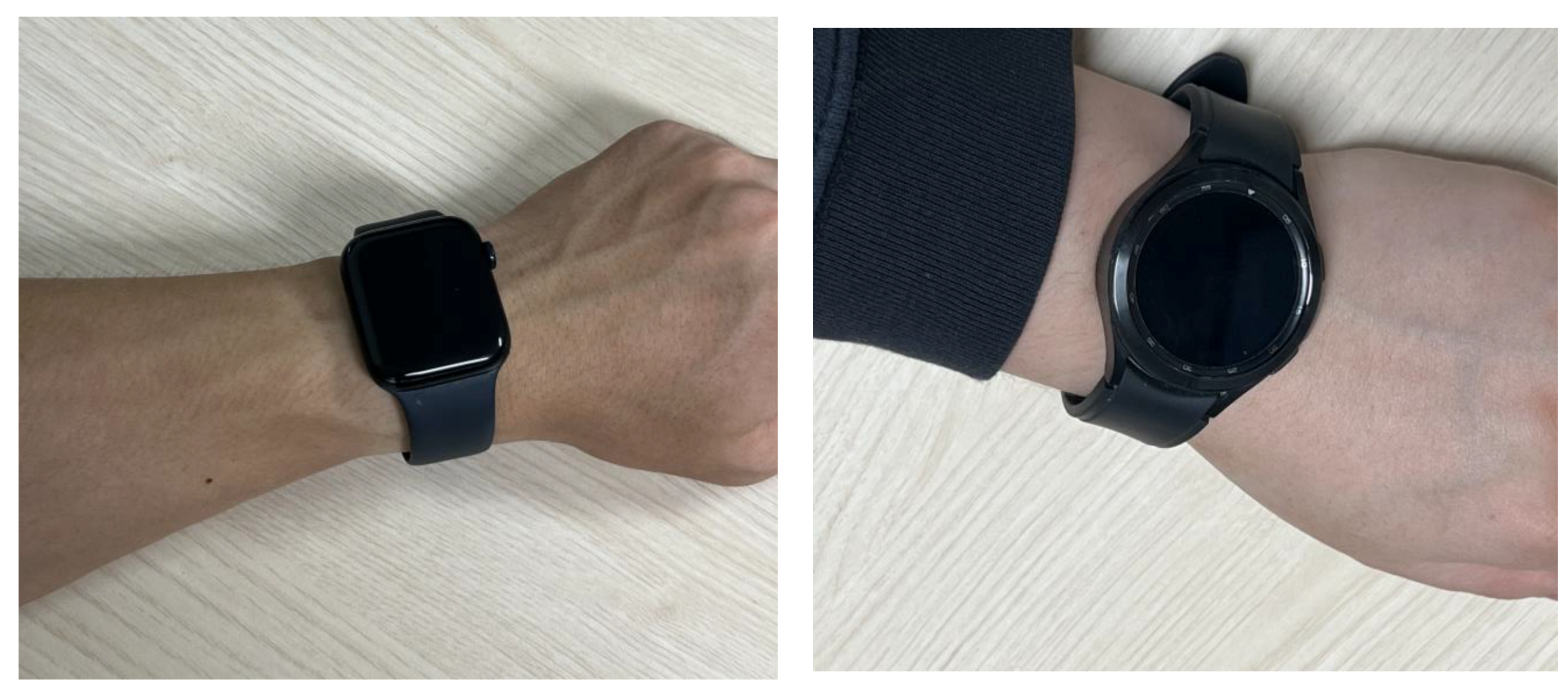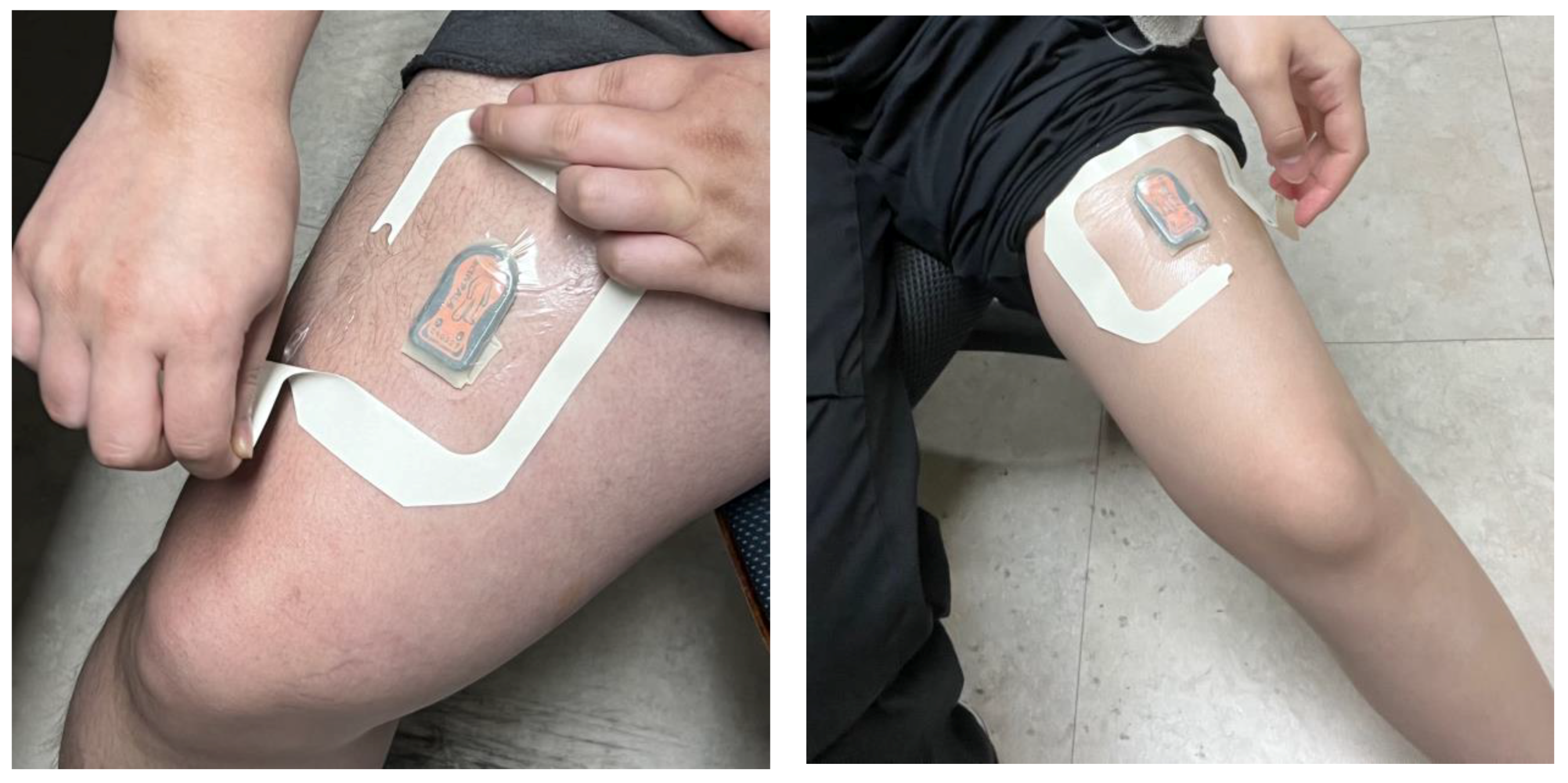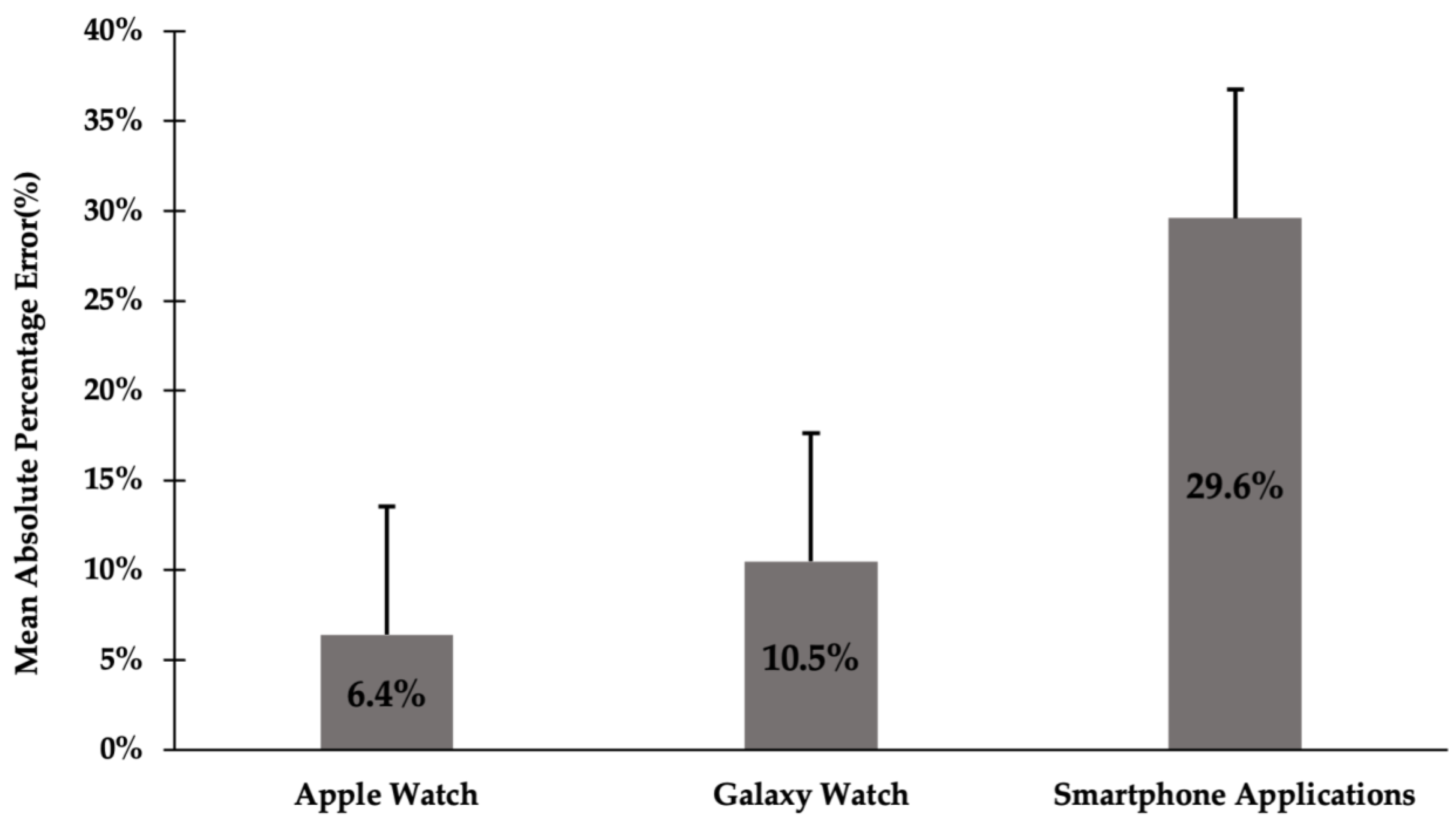Apple Watch 6 vs. Galaxy Watch 4: A Validity Study of Step-Count Estimation in Daily Activities
Abstract
:1. Introduction
2. Materials and Methods
2.1. Participants
2.2. Instruments
2.2.1. ActivPAL (ActivPAL 4 v8.12.6) (AP)
2.2.2. Smartwatches (Apple Watch 6 and Galaxy Watch 4)
2.3. Study Protocol
2.4. Data Analysis
3. Results
4. Discussion
5. Conclusions
Author Contributions
Funding
Institutional Review Board Statement
Informed Consent Statement
Data Availability Statement
Acknowledgments
Conflicts of Interest
References
- Rhodes, R.E.; Janssen, I.; Bredin, S.S.D.; Warburton, D.E.R.; Bauman, A. Physical activity: Health impact, prevalence, correlates and interventions. Psychol. Health 2017, 32, 942–975. [Google Scholar] [CrossRef] [PubMed]
- Degroote, L.; De Bourdeaudhuij, I.; Verloigne, M.; Poppe, L.; Crombez, G. The Accuracy of Smart Devices for Measuring Physical Activity in Daily Life: Validation Study. JMIR mHealth uHealth 2018, 6, e10972. [Google Scholar] [CrossRef] [PubMed]
- World Health Organization. Global Status Report on Physical Activity 2022: Country Profiles; World Health Organization: Geneva, Switzerland, 2022; Available online: https://www.who.int/publications/i/item/9789240064119 (accessed on 10 July 2022).
- Bassett, D.R., Jr.; Wyatt, H.R.; Thompson, H.; Peters, J.C.; Hill, J.O. Pedometer-measured physical activity and health behaviors in United States adults. Med. Sci. Sports Exerc. 2010, 42, 1819–1825. [Google Scholar] [CrossRef] [PubMed]
- World Health Organization. Global Status Report on Physical Activity 2022. Available online: https://www.who.int/teams/health-promotion/physical-activity/global-status-report-on-physical-activity-2022 (accessed on 6 July 2022).
- Coppetti, T.; Brauchlin, A.; Müggler, S.; Attinger-Toller, A.; Templin, C.; Schönrath, F.; Hellermann, J.; Lüscher, T.F.; Biaggi, P.; Wyss, C.A. Accuracy of smartphone apps for heart rate measurement. Eur. J. Prev. Cardiol. 2017, 24, 1287–1293. [Google Scholar] [CrossRef] [PubMed]
- Chan, M.; Estève, D.; Fourniols, J.-Y.; Escriba, C.; Campo, E. Smart wearable systems: Current status and future challenges. Artif. Intell. Med. 2012, 56, 137–156. [Google Scholar] [CrossRef] [PubMed]
- Appelboom, G.; Camacho, E.; Abraham, M.E.; Bruce, S.S.; Dumont, E.L.; Zacharia, B.E.; D’Amico, R.; Slomian, J.; Reginster, J.Y.; Bruyère, O. Smart wearable body sensors for patient self-assessment and monitoring. Arch. Public Health 2014, 72, 28. [Google Scholar] [CrossRef] [PubMed]
- Li, J.; Ma, Q.; Chan, A.H.S.; Man, S.S. Health monitoring through wearable technologies for older adults: Smart wearables acceptance model. Appl. Ergon. 2019, 75, 162–169. [Google Scholar] [CrossRef] [PubMed]
- Michie, S.; Abraham, C.; Whittington, C.; McAteer, J.; Gupta, S. Effective techniques in healthy eating and physical activity interventions: A meta-regression. Health Psychol 2009, 28, 690–701. [Google Scholar] [CrossRef]
- Williams, S.L.; French, D.P. What are the most effective intervention techniques for changing physical activity self-efficacy and physical activity behaviour—And are they the same? Health Educ. Res. 2011, 26, 308–322. [Google Scholar] [CrossRef] [PubMed]
- Forbes. The World’s Most Valuable Brands. Available online: https://www.forbes.com/powerful-brands/list/ (accessed on 17 April 2023).
- Research, C. Quarterly Smartwatch Unit Shipment Share Worldwide from 2018 to 2023, by Vendor. Available online: https://www.statista.com/statistics/910862/worldwide-smartwatch-shipment-market-share/#statisticContainer (accessed on 17 April 2023).
- Canalys. Apple Shipped Two-Thirds of All Smart Watches in 2015. Available online: https://www.canalys.com/static/press_release/2016/media-alert-05022016-apple-shipped-two-thirds-all-smart-watches-2015.pdf (accessed on 17 April 2023).
- Abt, G.; Bray, J.; Benson, A.C. Measuring Moderate-Intensity Exercise with the Apple Watch: Validation Study. JMIR Cardio 2018, 2, e6. [Google Scholar] [CrossRef]
- Raja, J.M.; Elsakr, C.; Roman, S.; Cave, B.; Pour-Ghaz, I.; Nanda, A.; Maturana, M.; Khouzam, R.N. Apple watch, wearables, and heart rhythm: Where do we stand? Ann. Transl. Med. 2019, 7, 417–422. [Google Scholar] [CrossRef] [PubMed]
- Kraus, W.E.; Janz, K.F.; Powell, K.E.; Campbell, W.W.; Jakicic, J.M.; Troiano, R.P.; Sprow, K.; Torres, A.; Piercy, K.L. Daily Step Counts for Measuring Physical Activity Exposure and Its Relation to Health. Med. Sci. Sports Exerc. 2019, 51, 1206–1212. [Google Scholar] [CrossRef] [PubMed]
- Chaudhry, U.A.R.; Wahlich, C.; Fortescue, R.; Cook, D.G.; Knightly, R.; Harris, T. The effects of step-count monitoring interventions on physical activity: Systematic review and meta-analysis of community-based randomised controlled trials in adults. Int. J. Behav. Nutr. Phys. Act. 2020, 17, 129–144. [Google Scholar] [CrossRef] [PubMed]
- Masi, E.; Peterman, J.E.; Kaminsky, L.A. The health benefits of a pedometer-based 100,000 steps/Week Physical Activity Program. J. Sci. Sport Exerc. 2019, 1, 176–183. [Google Scholar] [CrossRef]
- Ahmed Bhuiyan, R.; Ahmed, N.; Amiruzzaman, M.; Islam, M.R. A robust feature extraction model for human activity characterization using 3-axis accelerometer and gyroscope data. Sensors 2020, 20, 6990. [Google Scholar] [CrossRef] [PubMed]
- Wakaizumi, T.; Togawa, N. An indoor positioning method using smartphone and smartwatch independent of carrying modes. In Proceedings of the 2021 IEEE International Conference on Consumer Electronics (ICCE), Las Vegas, NV, USA, 10–12 January 2021; pp. 1–6. [Google Scholar]
- Sarhaddi, F.; Kazemi, K.; Azimi, I.; Cao, R.; Niela-Vilén, H.; Axelin, A.; Liljeberg, P.; Rahmani, A.M. A comprehensive accuracy assessment of Samsung smartwatch heart rate and heart rate variability. PLoS ONE 2022, 17, e0268361. [Google Scholar] [CrossRef] [PubMed]
- Støve, M.P.; Hansen, E.C.K. Accuracy of the Apple Watch Series 6 and the Whoop Band 3.0 for assessing heart rate during resistance exercises. J. Sports Sci. 2022, 40, 2639–2644. [Google Scholar] [CrossRef] [PubMed]
- Castro, J.M.C.; Martini, H.A. Potencia estadística y cálculo del tamaño del efecto en G* Power: Complementos a las pruebas de significación estadística y su aplicación en psicología. Salud Soc. 2014, 5, 210–244. [Google Scholar] [CrossRef]
- Naqvib, N.Z.; Kumar, A.; Chauhan, A.; Sahni, K. Step counting using smartphone-based accelerometer. Int. J. Comput. Sci. Eng. 2012, 4, 675–681. [Google Scholar]
- Kozey-Keadle, S.; Libertine, A.; Lyden, K.; Staudenmayer, J.; Freedson, P.S. Validation of wearable monitors for assessing sedentary behavior. Med. Sci. Sports Exerc. 2011, 43, 1561–1567. [Google Scholar] [CrossRef]
- An, H.-S.; Kim, Y.; Lee, J.-M. Accuracy of inclinometer functions of the activPAL and ActiGraph GT3X+: A focus on physical activity. Gait Posture 2017, 51, 174–180. [Google Scholar] [CrossRef]
- Wu, Y.; Petterson, J.L.; Bray, N.W.; Kimmerly, D.S.; O’Brien, M.W. Validity of the activPAL monitor to measure stepping activity and activity intensity: A systematic review. Gait Posture 2022, 97, 165–173. [Google Scholar] [CrossRef]
- Spaccarotella, C.; Polimeni, A.; Mancuso, C.; Pelaia, G.; Esposito, G.; Indolfi, C. Assessment of non-invasive measurements of oxygen saturation and heart rate with an Apple smartwatch: Comparison with a standard pulse oximeter. J. Clin. Med. 2022, 11, 1467. [Google Scholar] [CrossRef]
- Lee, B.-G.; Lee, B.-L.; Chung, W.-Y. Smartwatch-based driver alertness monitoring with wearable motion and physiological sensor. In Proceedings of the 2015 37th Annual International Conference of the IEEE Engineering in Medicine and Biology Society (EMBC), Milan, Italy, 25–29 August 2015; pp. 6126–6129. [Google Scholar]
- Liu, Z.; Zhao, Y.; Yin, Z. Low-power soft transistors triggering revolutionary electronics. Innovation 2024, 5, 100616. [Google Scholar] [CrossRef] [PubMed]
- Zhang, T.; Liu, N.; Xu, J.; Liu, Z.; Zhou, Y.; Yang, Y.; Li, S.; Huang, Y.; Jiang, S. Flexible electronics for cardiovascular healthcare monitoring. Innovation 2023, 4, 100485. [Google Scholar] [CrossRef] [PubMed]
- Hauck, W.W.; Anderson, S. A new statistical procedure for testing equivalence in two-group comparative bioavailability trials. J. Pharmacokinet. Biopharm. 1984, 12, 83–91. [Google Scholar] [CrossRef]
- Khushhal, A.; Nichols, S.; Evans, W.; Gleadall-Siddall, D.O.; Page, R.; O’Doherty, A.F.; Carroll, S.; Ingle, L.; Abt, G. Validity and reliability of the Apple Watch for measuring heart rate during exercise. Sports Med. Int. Open 2017, 1, E206–E211. [Google Scholar] [CrossRef] [PubMed]
- Hajj-Boutros, G.; Landry-Duval, M.-A.; Comtois, A.S.; Gouspillou, G.; Karelis, A.D. Wrist-worn devices for the measurement of heart rate and energy expenditure: A validation study for the Apple Watch 6, Polar Vantage V and Fitbit Sense. Eur. J. Sport Sci. 2023, 23, 165–177. [Google Scholar] [CrossRef]
- Veerabhadrappa, P.; Moran, M.D.; Renninger, M.D.; Rhudy, M.B.; Dreisbach, S.B.; Gift, K.M. Tracking steps on apple watch at different walking speeds. J. Gen. Intern. Med. 2018, 33, 795–796. [Google Scholar] [CrossRef]
- Hartung, V.; Sarshar, M.; Karle, V.; Shammas, L.; Rashid, A.; Roullier, P.; Eilers, C.; Mäurer, M.; Flachenecker, P.; Pfeifer, K. Validity of consumer activity monitors and an algorithm using smartphone data for measuring steps during different activity types. Int. J. Environ. Res. Public Health 2020, 17, 9314. [Google Scholar] [CrossRef]
- Hergenroeder, A.L.; Barone Gibbs, B.; Kotlarczyk, M.P.; Kowalsky, R.J.; Perera, S.; Brach, J.S. Accuracy of objective physical activity monitors in measuring steps in older adults. Gerontol. Geriatr. Med. 2018, 4, 2333721418781126. [Google Scholar] [CrossRef] [PubMed]
- Bai, Y.; Welk, G.J.; Nam, Y.H.; Lee, J.A.; Lee, J.-M.; Kim, Y.; Meier, N.F.; Dixon, P.M. Comparison of consumer and research monitors under semistructured settings. Med. Sci. Sports Exerc. 2016, 48, 151–158. [Google Scholar] [CrossRef] [PubMed]
- Fuller, D.; Colwell, E.; Low, J.; Orychock, K.; Tobin, M.A.; Simango, B.; Buote, R.; Van Heerden, D.; Luan, H.; Cullen, K. Reliability and validity of commercially available wearable devices for measuring steps, energy expenditure, and heart rate: Systematic review. JMIR mHealth uHealth 2020, 8, e18694. [Google Scholar] [CrossRef]
- Bai, Y.; Hibbing, P.; Mantis, C.; Welk, G.J. Comparative evaluation of heart rate-based monitors: Apple Watch vs Fitbit Charge HR. J. Sports Sci. 2018, 36, 1734–1741. [Google Scholar] [CrossRef] [PubMed]
- Moreno, J.J.M.; Pol, A.P.; Abad, A.S.; Blasco, B.C. Using the R-MAPE index as a resistant measure of forecast accuracy. Psicothema 2013, 25, 500–506. [Google Scholar]
- Höchsmann, C.; Knaier, R.; Eymann, J.; Hintermann, J.; Infanger, D.; Schmidt-Trucksäss, A. Validity of activity trackers, smartphones, and phone applications to measure steps in various walking conditions. Scand. J. Med. Sci. Sports 2018, 28, 1818–1827. [Google Scholar] [CrossRef]
- Presset, B.; Laurenczy, B.; Malatesta, D.; Barral, J. Accuracy of a smartphone pedometer application according to different speeds and mobile phone locations in a laboratory context. J. Exerc. Sci. Fit. 2018, 16, 43–48. [Google Scholar] [CrossRef]
- Henriksen, A.; Haugen Mikalsen, M.; Woldaregay, A.Z.; Muzny, M.; Hartvigsen, G.; Hopstock, L.A.; Grimsgaard, S. Using fitness trackers and smartwatches to measure physical activity in research: Analysis of consumer wrist-worn wearables. J. Med. Internet Res. 2018, 20, e110. [Google Scholar] [CrossRef]






| Device | Version | Location Worn | Software |
|---|---|---|---|
| ActivPAL (PAL Technologies Ltd., Glasgow, UK) | ActivPAL4 | Thigh | AcivPAL4 v8.12.6 |
| Apple Watch (Apple, Cupertino, CA, USA) | Apple Watch se2 | Wrist | Apple Watch 6 v9.3.1 |
| Galaxy Watch (Samsung, Suwon-si, Republic of Korea) | Galaxy Watch 4 | Wrist | Galaxy Watch 4 v2.2.11.23082851 |
| Apple iPhone (Apple, Cupertino, CA, USA) | iPhone | - | iPhone app; Health (iOS 16) |
| Samsung Galaxy Phone (Samsung, Suwon-si, Republic of Korea) | Galaxy Phone | - | Galaxy Phone app; Samsung Health (UI 5.0) |
| Variables | Apple Watch | Galaxy Watch | Smartphone Applications | |||||
|---|---|---|---|---|---|---|---|---|
| No. (%) | Mean (SD) | No. (%) | Mean (SD) | No. (%) | Mean (SD) | |||
| Gender | Male | 17 (47.2%) | - | 10 (40%) | - | 21 (48.8%) | - | |
| Female | 19 (52.8%) | - | 15 (60%) | - | 22 (51.2%) | - | ||
| Anthropometrics | Male | Age (year) | 17 | 25.7 (5.6) | 10 | 31.1 (11.8) | 21 | 27.9 (8.6) |
| Height (cm) | 175.2 (0.1) | 177.0 (0.0) | 176.0 (0.1) | |||||
| Weight (kg) | 73.9 (6.9) | 82.7 (13.1) | 77.4 (8.7) | |||||
| BMI (kg/m2) | 24.1 (1.6) | 26.4 (4.3) | 25.0 (2.5) | |||||
| Female | Age (year) | 19 | 23.3 (3.6) | 15 | 27.3 (10.2) | 22 | 25.0 (5.1) | |
| Height (cm) | 163.8 (0.0) | 165.9 (0.0) | 163.8 (0.0) | |||||
| Weight (kg) | 50.3 (3.6) | 52.3 (1.8) | 52.6 (3.7) | |||||
| BMI (kg/m2) | 18.8 (1.4) | 19.0 (1.3) | 19.6 (1.3) | |||||
| Total | Age (year) | 36 | 24.4 (4.7) | 25 | 28.8 (10.8) | 43 | 26.4 (7.1) | |
| Height (cm) | 169.2 (0.1) | 170.4 (0.1) | 169.7 (0.1) | |||||
| Weight (kg) | 61.5 (13.1) | 64.5 (17.2) | 64.7 (14.1) | |||||
| BMI (kg/m2) | 21.3 (3.1) | 22.0 (4.6) | 22.2 (3.4) | |||||
| Correlation | ||||
|---|---|---|---|---|
| ActivPAL | Apple Watch | Galaxy Watch | Smartphone Applications | |
| ActivPAL | 1 | 0.986 ** | 0.824 ** | 0.926 ** |
Disclaimer/Publisher’s Note: The statements, opinions and data contained in all publications are solely those of the individual author(s) and contributor(s) and not of MDPI and/or the editor(s). MDPI and/or the editor(s) disclaim responsibility for any injury to people or property resulting from any ideas, methods, instructions or products referred to in the content. |
© 2024 by the authors. Licensee MDPI, Basel, Switzerland. This article is an open access article distributed under the terms and conditions of the Creative Commons Attribution (CC BY) license (https://creativecommons.org/licenses/by/4.0/).
Share and Cite
Hong, K.-R.; Hwang, I.-W.; Kim, H.-J.; Yang, S.-H.; Lee, J.-M. Apple Watch 6 vs. Galaxy Watch 4: A Validity Study of Step-Count Estimation in Daily Activities. Sensors 2024, 24, 4658. https://doi.org/10.3390/s24144658
Hong K-R, Hwang I-W, Kim H-J, Yang S-H, Lee J-M. Apple Watch 6 vs. Galaxy Watch 4: A Validity Study of Step-Count Estimation in Daily Activities. Sensors. 2024; 24(14):4658. https://doi.org/10.3390/s24144658
Chicago/Turabian StyleHong, Kyu-Ri, In-Whi Hwang, Ho-Jun Kim, Seo-Hyung Yang, and Jung-Min Lee. 2024. "Apple Watch 6 vs. Galaxy Watch 4: A Validity Study of Step-Count Estimation in Daily Activities" Sensors 24, no. 14: 4658. https://doi.org/10.3390/s24144658






